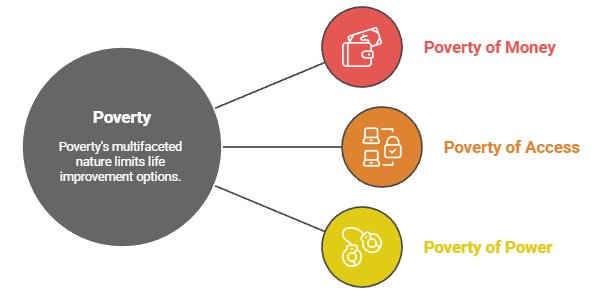Poverty and SD
overty has essentially three closely interrelated aspects, namely, "poverty of money", "poverty of access", and "poverty of power." These three aspects of poverty make the working, living and social environments of the poor extremely insecure and severely limit the choices or the options available to the poor to improve their lives. Without choices and security, breaking the cycle of poverty becomes virtually impossible and leads to the marginalization and alienation of the poor from society.
Figure 1: The Three Aspects of PovertyPoverty of money
The most prevalent means of measuring poverty have been and continue to be those related to money. Measures such as poverty lines, Gini-coefficients etc. are used to measure absolute and relative poverty in terms of incomes and affordability. Measuring poverty in terms of income and affordability is prevalent because such measurements are relatively easy make and quantify.
However, the lack of money is more a symptom of poverty rather than its cause. In most cases the poor are not without an income, what they lack is the ability to accumulate assets, which is a key ingredient to the creation of wealth and breaking the cycle of poverty.
Besides their low earnings, the prime reason for their inability to accumulate assets and thus increase their security of income is that their profits or potential savings are often appropriated by moneylenders who charge usurious interest rates, by formal and informal regulatory and enforcement agents/organizations who demand bribes or extort protection money, and by middlemen or other stronger business partners who exploit the poor because the poor lack market information or the ability to use that market information to increase their own incomes.
Another key reason that prevents the poor from accumulating capital is that they are often forced to purchase public goods and services that are readily available to other groups in society at market or below market prices, at much higher costs. This leads us to the discussion of the second aspect of poverty, i.e. "poverty of access".
Poverty of access
Most of the urban poor live in overcrowded and unsanitary slums and squatter settlements and often do not have access to basic infrastructure and services. They are forced to live in illegal and informal settlements because they cannot enter the formal land and housing markets. The reasons for the formation of slums and squatter settlements are numerous and have been discussed extensively in development literature. Suffice it to say here that due to the way the formal markets are regulated and structured, the poor are unable to afford the choices offered to them in these markets. In contrast, the informal and illegal housing markets of slums and squatter settlements are specifically geared to meet their shelter needs.
However, like other informal markets, the informal land and housing market is exploitative and has several negative impacts. First and foremost informal settlements are often located on marginal land (along river-banks, railway lines, steep slopes and on or near garbage dumps) and are prone to natural and man-made disasters. They are also often illegal and those living there do not have security of tenure. Because of their illegal status they are often not provided with formal basic infrastructure and services such as piped water, electricity, wastewater disposal and solid waste collection by government agencies and organizations and have to purchase these in the informal markets, often paying much more than higher-income groups. Studies in several cities have shown that the poor end up paying two to five times as much for informal access to public goods and services than higher income groups.
Because there is often no security of tenure in illegal settlements and the fear of imminent eviction exists, the poor do not invest in improving either their housing or their settlements. The lack of basic environmental infrastructure and their location on marginal land often translates into higher rates of diseases and lower life spans. The consequent higher medical bills, lost working days and early demise of income earners further expropriate their marginal income and cements the cycle of poverty.
Similarly, the children of the poor are unable to access good education. Often the standards and facilities of the educational institutes they can afford are lower than those available to children of higher income groups. Moreover, poor children often drop out of school earlier to support their families. Poor education also contributes to entrenchment of the cycle of poverty.
Poverty of power
The poor suffer from both traditional and modern environmental health risks in urban areas. They suffer from diseases associated with poor sanitation, lack of clean water, overcrowded and poorly ventilated living and working environments as well as from modern risks caused by air and industrial pollution. While the poor suffer the most from dysfunctions in cities, they are the least able, as individuals, to influence how cities are governed.
In many cities, both formal structures of government and the culture of governance tend to exclude the poor from decision-making and tend to concentrate decision-making among a small number of formal and informal elite. The poor have greater possibility to influence decision-making under conditions of good governance, i.e. a system of government and a culture of governance that is participatory, inclusive, consensus oriented, based on the rule of law, responsive to the needs of the population, efficient, transparent and accountable.
Another important aspect of power is information. The poor often lack access to information that they can use to advance their case when dealing with other actors in the city. Even when information is available, it is often in medias and forms that are either not accessible to the poor or not understandable by the poor.
Source: UN-ESCAP, "Issue paper on Urban Poverty Alleviation in Asia and the Pacific", October 2000
 |
Return to the Poverty Pages Contact: Hari Srinivas - hsrinivas@gdrc.org |
